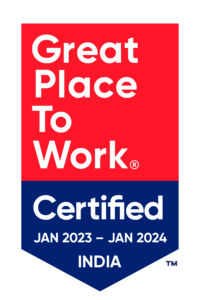11 Apr

Are you confused about the differences between traditional and agile project management? Trying to decide which approach will work best for your team? Don’t worry; we have you covered.
In this blog post, we’ll explore what sets these two approaches apart and provide advice on which might be right for you.
What is Project management?
Project management is managing all the resources, tasks, and goals that go into completing a project. It plans and organizes work, sets deadlines, tracks progress, and maintains stakeholder communication.
Project management helps teams stay organized and focused on their goals, and it also allows for more efficient use of resources and helps to ensure that project deadlines are met. Traditional project management is a linear process focusing on upfront planning where factors like cost, scope, and time are important.
Agile project management is much more flexible than the traditional approach. It relies on smaller groups and interactive releases throughout a project, and it puts more emphasis on individuals and interactions while also giving stakeholders more control over the project.
Also Read: Project Management Hacks 101: Handbook for assured Success
Introduction to Agile and Traditional Project Management
Project management involves planning, organizing, motivating, and controlling resources and processes to achieve specific goals. There are two main project management approaches the traditional and agile approaches.
Traditional Project Management
Traditional project management, also known as the Waterfall method, is a linear and sequential approach to project management. It follows a strict methodology where each project phase, such as planning, design, development, and testing, must be completed before moving on to the next step. This method is best suited for projects with well-defined requirements and predictable outcomes.
The Waterfall model consists of several phases, such as:
- Requirements gathering and analysis
- Design
- Development
- Testing
- Deployment
- Maintenance
One of the key characteristics of traditional project management is the heavy emphasis on planning and design. This includes creating a detailed project plan, outlining the project’s scope, and identifying the resources required to complete the project. The project plan is then used as a roadmap for the entire project and serves as a reference point for all stakeholders.
Another characteristic of traditional project management is the focus on deliverables and completion. This means that the project manager is responsible for ensuring the project is completed on time and within budget. This is achieved by establishing strict change management processes and ensuring that all stakeholders adhere to the project plan.
The team roles and responsibilities are fixed in traditional project management, meaning that each team member has a specific role and is responsible for specific tasks. This approach allows for clear communication and a clear chain of command but can also limit the team’s ability to adapt and make changes as the project progresses.
Risk management in traditional project management is proactive, meaning that the project manager identifies potential risks before they occur and takes steps to mitigate them. This is achieved by creating a risk management plan and regularly reviewing it throughout the project.
Also Read: Supercharge your Productivity with an Effective Task Management System
Agile Project Management
Agile software development is a general approach that emphasizes teamwork, collaboration, timeboxing, and flexibility to respond quickly to change.
Agile management certifications emphasize teamwork, customer collaboration, and flexibility. With each software development iteration, this approach focuses on incorporating customer feedback and releasing continuous updates.
Agile software development emphasizes changes and collaboration over a predefined process to deliver results. Agile’s adaptive planning is perhaps its best feature, making it a favorite of project managers worldwide.
Agile frameworks such as Scrum and Kanban are widely used. In addition to encouraging decision-making, they prevent time consumption on variables that are likely to change. At every stage of the software development process, the company emphasizes customer satisfaction and uses available teams to speed up development.
Advantages and Disadvantages
Below are the advantages and disadvantages of Traditional Project Management and Agile Project Management.
Advantages of Agile Project Management
- There are many benefits of agile project management over the traditional project management approach. It is much more flexible and allows teams to adapt to changes during the project.
- It also encourages collaboration between team members by breaking down projects into smaller and more manageable sprints. This helps to ensure that teams stay on track and that potential issues can be identified and addressed quickly.
- Furthermore, its iterative process requires less time for upfront planning, resulting in faster delivery times, lower costs and improved business value.
- Finally, agile methodology encourages customer feedback which helps to refine the project and ensure higher-quality results.

Disadvantages of Agile Project Management
- However, agile project management methods have their drawbacks. It is not suitable for large and complex projects since it relies on small groups and interactive releases throughout the project.
- Additionally, documentation is done during the project, which can become tedious and increase the time it takes to complete the project.
- Furthermore, agile does not focus on upfront planning, which means that other factors such as cost, scope, and time are not given enough importance.
Advantages of Traditional Project Management
- Traditional project management is a well-established approach that offers many advantages. It is ideal for large and complex projects requiring high control, accuracy, and predictability levels.
- It allows project managers to plan extensively and set clear objectives and expectations. This helps ensure that all stakeholders are on the same page and that the project progresses according to plan.
- Traditional project management also allows for better risk management and more accurate budgeting, making it ideal for projects with tight deadlines and limited resources.
- Additionally, this approach allows for a thorough documentation of each step of the process, making it easier for team members to stay on track and for external auditors to ensure compliance.
Disadvantages of Traditional Project Management
- Traditional project management is linear and does not provide much space for evolution.
- It also lacks flexibility, as the project manager must approve changes. Moreover, it is unsuitable for large and complex projects as it does not allow the team to backpedal. As a result, it can be challenging to keep up with the changing demands of larger projects.
- Additionally, traditional project management does not offer much room for creativity and innovation, as each process step is predetermined.
Also Read: Revamp Project Management with No-Code
Difference between Traditional and Agile Project Methodology
The table below shows the significant differences between traditional and agile project methodologies.
| Traditional Methodology | Agile Methodology |
|---|---|
| The Waterfall model is used. | Iterative and incremental development. |
| Emphasis on planning and design. | Emphasis on flexibility and adaptability. |
| Emphasis on deliverables and completion | Emphasis on customer satisfaction |
| Projects are completed in phases. | Projects are completed in sprints. |
| The strict change management process. | Encourages changes and improvements. |
| Team roles and responsibilities are fixed. | Team roles and responsibilities are flexible. |
| Limited customer involvement | High customer involvement |
| Risk management is proactive | Risk management is reactive |
| Suitable for projects with well-defined requirements | Suitable for projects with changing requirements |
Specific Examples of Agile and Traditional Project Development
Building a bridge
A large-scale construction project like the Golden Gate Bridge is a perfect example of a project suited for traditional project management. The engineers had clearly defined goals (connect San Francisco to Marin County), strict regulations to adhere to (seismic safety, wind tolerance), and a well-defined design based on blueprints. The traditional approach’s focus on phased development (planning, construction of foundations, towers, suspension cables, roadway) and risk mitigation (extensive soil testing, wind tunnel simulations) ensured the bridge’s successful completion in 1937, on time and within budget.
Developing a mobile app
An app like Instagram is a great example of a project that thrives on agile methodology. With constantly evolving features and a heavy reliance on user feedback, Instagram utilizes an agile approach. The iterative approach allows the development team to quickly integrate new features based on user trends and feedback (like Stories, Reels, and Shopping). This ensures the app stays relevant and engaging for its user base.
How do you choose between Traditional and Agile Project Management?
When deciding between traditional and agile project management, it is essential to consider the size and scope of the project, the team’s competencies, and the available resources.
Agile is ideal for smaller projects with short turnaround times, and it is also great for projects requiring frequent customer or stakeholder feedback. On the other hand, traditional project management is better suited for larger projects that require upfront planning and more rigid processes.
Choosing between traditional and agile project management depends on several factors specific to your project. Here’s a breakdown to help you decide:
Consider Traditional Project Management if
- Your project has well-defined requirements and a clear scope: If you have a blueprint and all the specifications are set in stone, traditional methods provide a structured roadmap to follow. (e.g., Building a bridge)
- Predictability is crucial: Traditional methods excel at planning and risk mitigation, ensuring projects stay on track and within budget. (e.g., Developing a new aircraft)
- Strict regulations or compliance is necessary: The focus on detailed documentation in traditional methods makes it ideal for adhering to industry standards or legal requirements. (e.g., Launching a new medical device)
- Your team thrives on a structured environment: If your team prefers clear roles and a defined process, the traditional approach can provide stability and organization.
Consider Agile Project Management if
- Your project has evolving requirements or uncertainty: If the needs of the project are likely to change, agile allows for flexibility and adaptation based on new information. (e.g., Developing a mobile app)
- Faster delivery is a priority: Agile focuses on delivering working features in short sprints, getting a product to market quicker and gathering user feedback earlier. (e.g., Designing a new website)
- Collaboration and innovation are key: The emphasis on teamwork and continuous feedback in agile fosters a creative environment where ideas can be tested and refined quickly. (e.g., Developing a new marketing campaign)
- Your team is comfortable with a dynamic approach: If your team enjoys working in short cycles and adapting to change, agile can be a motivating and engaging methodology.
Hybrid Approach
Many projects fall somewhere in between the traditional and agile extremes. The hybrid approach combines elements of both methodologies to create a customized solution that fits the specific needs of the project.
For example, a project with a well-defined core functionality but some room for user feedback might use a traditional approach for the core features and an agile approach for peripheral or evolving functionalities.
Scalability
Traditional project management is generally better suited for smaller teams working on well-defined projects with a clear scope. As projects become larger and more complex, the rigid structure of traditional methods can become cumbersome.
Agile methodologies, on the other hand, are more scalable and can adapt to accommodate larger teams and evolving project requirements.
The choice between traditional and agile project management depends on the specific needs of your project. Consider the size and complexity of the project, the level of uncertainty involved, and the team’s experience and skillset. By understanding the strengths and weaknesses of each approach, you can make an informed decision and select the methodology that will lead to your project’s success.
Additional Tips:
- Consider team size and experience: Larger teams or those new to project management might benefit from the structure of traditional methods. Agile can work well for smaller, experienced teams.
- Evaluate project complexity: Highly complex projects with numerous dependencies might be better suited for traditional methods. Agile is often a good choice for simpler projects.
- Think about stakeholder involvement: Traditional methods offer clear communication through defined phases. Agile thrives on continuous stakeholder engagement.
Also Read: SDLC Vs Agile: Which one is the best?
Traditional vs Agile Project Management: A Toolset Showdown
Choosing the right project management methodology (traditional or agile) is crucial for project success. But your methodology is only half the battle. Selecting the most appropriate tools to support your chosen approach is equally important. In this section, we’ll delve into the key differences between traditional and agile project management tools, focusing on the growing trend of low-code, no-code options.
Traditional Project Management Tools: Built for Structure and Control
Traditional project management tools prioritize detailed planning, resource allocation, and progress tracking. They cater to a structured approach, ensuring projects stay on schedule and within budget.
- Focus:
- Meticulous planning and task management
- Efficient resource allocation
- Comprehensive progress tracking and reporting
- Features:
- Gantt charts for visualizing project timelines and dependencies
- Critical path analysis to identify potential bottlenecks
- Workload management for optimizing team resource allocation
- Document sharing and collaboration features
- Robust reporting capabilities for project health insights
- Low-Code/No-Code Integration:
Traditional tools typically offer limited built-in low-code no-code functionalities. Integrations with separate platforms like Quixy might be required for custom workflows or automation.
Agile Project Management Tools: Embracing Flexibility and Collaboration
Agile project management tools prioritize rapid iteration, collaboration, and continuous feedback. They empower teams to adapt quickly to changing requirements and deliver value in short cycles.
- Focus:
- Iterative development with frequent sprints
- Streamlined collaboration and communication
- Prioritization and management of user stories
- Integration with version control systems for code management
- Features:
- Kanban boards for visualizing workflow stages and task progress
- User story management for capturing and prioritizing requirements
- Sprint planning tools for defining work scope for each iteration
- Real-time communication features like chat and video conferencing
- Low-Code/No-Code Integration:
Many agile project management tools are embracing low-code/no-code functionalities. This allows users to: * Customize workflows to adapt to specific project needs * Automate repetitive tasks for increased efficiency * Build simple applications directly within the platform to extend functionalities
Benefits of Low-Code/No-Code in Project Management
The rise of low-code/no-code tools within project management platforms offers several advantages:
- Increased Efficiency: Automate repetitive tasks like sending notifications or generating reports, freeing up valuable time for more strategic work.
- Improved Flexibility: Easily customize workflows to adapt to changing project needs without relying on developers.
- Enhanced Collaboration: Some tools offer built-in features for real-time communication and data sharing, fostering collaboration within teams.
- Accessibility for Non-Technical Users: Empower team members with limited technical expertise to contribute to project management tasks.
Choosing the Right Tool for Your Project
The ideal project management toolset depends on your specific project and team. Here are some additional factors to consider:
- Project size and complexity: Larger, more intricate projects might necessitate robust traditional tools with advanced features.
- Team experience: For teams new to project management, a user-friendly and visual tool like a Kanban board might be ideal.
- Budget: Traditional tools often require licensing fees, while many agile tools offer freemium plans or subscription models.
The Power of Choice and Customization
Both traditional and agile project management tools offer valuable functionalities. The growing adoption of low-code/no-code functionalities empowers teams with more flexibility, automation capabilities, and the potential for citizen developers to contribute. By carefully considering your project’s requirements and team dynamics, you can select the right methodology, tools, and level of customization to ensure your project’s success.
Conclusion
When choosing between traditional and agile project management, it is essential to consider your project and its goals. Traditional project management is more suited for less complicated tasks, while agile project management is better suited for projects that require quick adjustment and modifications.
Adaptive agile project management also tends to be more collaborative and cost-effective, resulting in better digital transformational results. The choice between the two ultimately depends on the needs of your project and the resources available.
Frequently Asked Questions(FAQs)
Q. Can I switch between traditional and agile during a project?
Yes, absolutely! While it’s ideal to choose a methodology at the outset, projects can be dynamic. If circumstances change, you can adapt your approach to better suit the project’s current needs.
Q. Is one methodology inherently better than the other?
There’s no single “best” approach. Traditional project management excels in structured environments with clear goals, while agile shines in projects with evolving requirements. The best method depends on your specific project needs.
Q. What common mistakes do people make when choosing a project management methodology?
A common mistake is prioritizing a specific methodology (traditional or agile) over the needs of the project itself. It’s crucial to analyze the project’s specific requirements before making a selection. Another mistake is neglecting stakeholder involvement. Regardless of the methodology, clear communication and stakeholder buy-in are essential for project success.
Q. How can I measure the success of a project using an agile methodology?
While traditional project management often focuses on meeting deadlines and staying within budget, agile success measurement can be more nuanced. Key metrics might include sprint completion rates, user satisfaction through feedback surveys, and the number of bugs identified and resolved.
Subscribe
Login
Please login to comment
0 Comments














